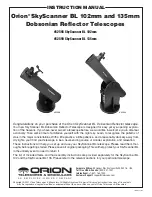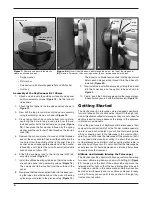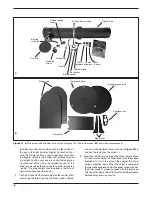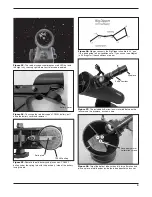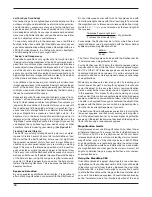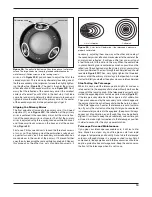
11
surface meets the dark portion. Due to the low angle at which
sunlight strikes this part of the Moon, shadows cast by crater
walls and other high-elevation features are elongated, thereby
making such features stand out more vividly. Using a red flash-
light (sold separately) to read the MoonMap in the dark will be
helpful; the red light will not spoil your eyes’ dark adaptation.
What to Expect
So what will you see with your telescope? You should be able to
see bands on Jupiter, the rings of Saturn, craters on the Moon,
the waxing and waning of Venus, and many bright deep-sky
objects. Do not expect to see color as you do in NASA photos,
since those are taken with long-exposure cameras and have
“false color” added. Our eyes are not sensitive enough to see
color in deep-sky objects except in a few of the brightest ones.
But remember that you are seeing these objects using your own
telescope with your own eyes, in real time. And that’s pretty cool!
Objects to Observe
Now that you are all set up and ready to go, one critical decision
must be made: what to look at?
A. The Moon
With its rocky surface, the Moon is one of the easiest and most
interesting targets to view with your telescope. Lunar craters,
maria, and even mountain ranges can all be clearly seen from a
distance of 238,000 miles away! With its ever-changing phases,
you’ll get a new view of the Moon every night. The best time to
observe our one and only natural satellite is during a partial
phase, that is, when the Moon is NOT full. During partial phases,
shadows are cast on the surface, which reveal more detail,
especially right along the border between the dark and light
portions of the disk (called the “terminator”). A full Moon is too
bright and devoid of surface shadows to yield a pleasing view.
Make sure to observe the Moon when it is well above the hori-
zon to get the sharpest images. Use an optional Moon filter
to dim the Moon when it is very bright. It simply threads onto
the bottom of the eyepiece barrel. You’ll find that a Moon filter
improves viewing comfort, and also helps to bring out subtle
features on the lunar surface.
B. The Sun
You can change your nighttime telescope into a daytime Sun
viewer by installing an optional full-aperture solar filter over the
front opening of the SkyScanner BL. The primary attraction is
sunspots, which change shape, appearance, and location daily.
Sunspots are directly related to magnetic activity in the Sun.
Many observers like to make drawings of sunspots to monitor
how the Sun is changing from day to day.
Important Note:
Do not look at the Sun with this telescope
without a professionally made solar filter installed on the front
opening, or permanent eye damage could result. Do not use
the red dot scope when solar viewing, either.
C. The Planets
Planets, being in our own solar system and having their own
orbits, do not stay at “fixed” locations like the stars do. So to
find them you should refer to Sky Calendar at our website (tele-
scope.com), or to charts published monthly in Astronomy, Sky
& Telescope, or other astronomy magazines. Venus, Jupiter,
and Saturn are the brightest objects in the sky after the Sun
and the Moon. Your SkyScanner BL is capable of showing you
these planets in some detail. Other planets may be visible but
will likely appear star-like. Because planets are quite small in
apparent size, you will need to use high power (the 3X Barlow
lens should come in handy here). Not all the planets are gener-
ally visible at any one time.
JUPITER: The largest planet, Jupiter, is a great subject for obser-
vation. You can see the disk of the giant planet and watch the
ever-changing positions of its four largest moons - Io, Callisto,
Europa, and Ganymede.
SATURN: The ringed planet is a breathtaking sight when it is
well positioned. The tilt angle of the rings varies over a period of
many years; sometimes they are seen edge-on, while at other
times they are broadside and look like giant “ears” on each side
of Saturn’s disk. A steady atmosphere (good seeing) is neces-
sary for a good view. You will probably see a bright “star” close
by, which is Saturn’s brightest moon, Titan.
VENUS: At its brightest, Venus is the most luminous object in
the sky, excluding the Sun and the Moon. It is so bright that
sometimes it is visible to the naked eye during full daylight! Ironi-
cally, Venus appears as a thin crescent, not a full disk, when at
its peak brightness. Because it is so close to the Sun, it never
wanders too far from the morning or evening horizon. No surface
markings can be seen on Venus, which is always shrouded in
dense clouds.
D. The Stars
Stars will appear like twinkling points of light. Even powerful
telescopes cannot magnify stars to appear as more than a point
of light. You can, however, enjoy the different colors of the stars
and locate many pretty double and multiple stars. The gorgeous
two-color double star Albireo in Cygnus is a favorites. Defocus-
ing a star slightly can help bring out its color.
E. Deep-Sky Objects
Under dark skies, you can observe a wealth of fascinating deep-
sky objects, including gaseous nebulas, open and globular
star clusters, and a variety of different types of galaxies. Most
deep-sky objects are very faint, so it is important that you find
an observing site well away from light pollution. Take plenty of
time to let your eyes adjust to the darkness. Do not expect these
subjects to appear like the photographs you see in books and
magazines; most will look like dim gray smudges. Our eyes are
not sensitive enough to see color in deep-sky objects. But as
you become more experienced and your observing skills get
sharper, you will be able to ferret out more and more subtle
details and structure.
To find deep sky objects in the sky, it is best to consult a star
chart or planisphere. These guides will help you locate the
brightest and best deep-sky objects for viewing with your
SkyScanner BL. You can also try low-power scanning of the
Milky Way. Pop in the 25mm eyepiece and just cruise through
the “star clouds” of our galaxy. You’ll be amazed at the rich fields
of stars and objects you’ll see! The Milky Way is best observed
on summer and winter evenings.
Summary of Contents for 52598
Page 15: ...15 ...

